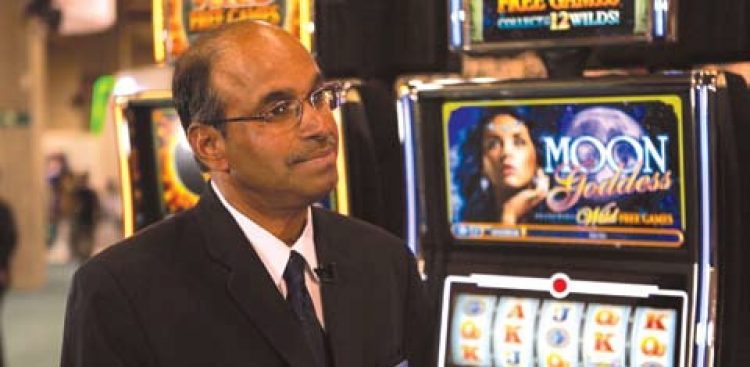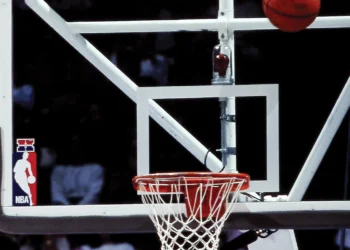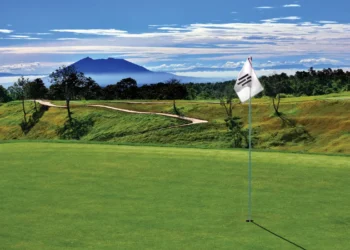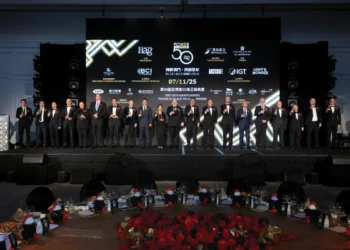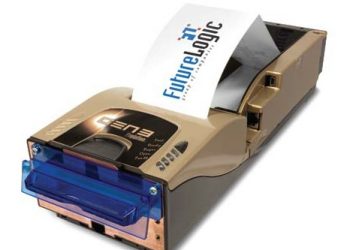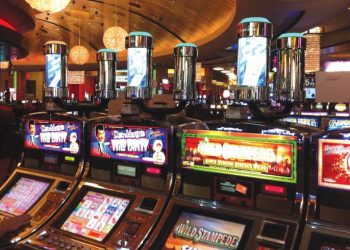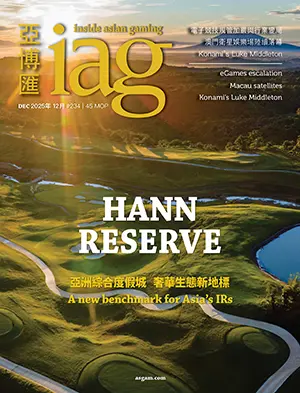Bally Technologies COO Ramesh Srinivasan and Managing Director of Asia-Pacific Kurt Gissane discuss the company’s steadfast commitment to product development and heightened focus on Asian markets
Michael Jackson King of Pop was one of the highlight attractions at Bally Technologies’ G2E Asia 2012 stand, which featured several big-name international licensed titles, as well as several games developed specifically with Asian players in mind. Also displayed at the Bally stand were the company’s market-leading systems offering, as well as its recent mobile gaming and interactive solutions.
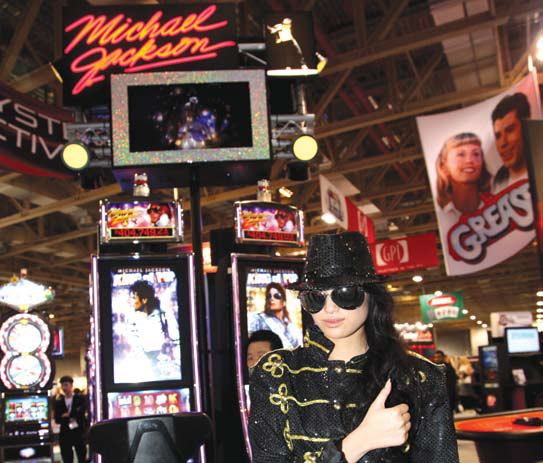
Bally’s Michael Jackson King of Pop on display at G2E Asia 2012
At the show, Inside Asian Gaming Publisher Kareem Jalal caught up with Bally Technologies COO Ramesh Srinivasan and Managing Director of Asia-Pacific Kurt Gissane for a video interview, excerpts of which can be viewed online at the IAG website, www.asgam.com. The full transcript of the interview follows. First off is the discussion with Mr Srinivasan.
Kareem Jalal: Bally is of course the leader in casino systems globally. How would you account for that lead?
Ramesh Srinivasan: Yes, Bally is in a leadership position in systems, and it has taken a lot of investments to get it there. We’ve done a lot of hard work over the last five, six years. We’ve invested a lot in recruiting great people. We’ve invested a lot in redoing and re-engineering a lot of our products. We’ve incorporated a lot of the features our customers wanted us to incorporate. We’ve made our products a lot more configurable. We’ve added a lot more tools to the systems that help with marketing, that help with casino operations. So it has taken a lot of R&D and people investments to get us to that position.
To keep the lead you have to be responsive to evolving market needs. How do you keep your development teams responsive and sharp?
The way we keep our product development team responsive and sharp is through managing product management well. We have a product management division whose entire purpose in life is to decide the future versions of the products and the future directions of the products. So product development executes the ideas that product management comes up with. And product management stays in touch with technology trends in the industry, talks to customers, attends seminars, attends customer advisory panels, listens to customers, and prioritizes that list and makes sure it represents all the markets all over the world, to make sure that what the Macau customers want, what the Asian customers want, is there.
Product management make up the list, and product development executes on that. So that’s how we keep product development controlled and sharp.
And would you say your development teams are perhaps bigger or more highly skilled than those of your competitors?
I would guess so. I want to be humble about who we are. I’m sure our competitors also do great work. But in terms of the scalability, in terms of the amount of R&D we do, in systems alone we have about an 800 plus R&D team. That is by far the largest R&D team ever built in gaming systems in the history of gaming. No company has ever taken systems as seriously as we have taken it over the last few years. So an 850 person R&D team that is disciplined and focused and an extraordinarily talented team is pushing the products forward at a very rapid pace.
Among the innovations you’ve got on display here is the industry’s first curved LCD, which offers a realistic reel-like experience. What is the thinking behind that product? We’ve talked about your software development. Can you tell us a bit about the hardware development process?
Actually the hardware development and the hardware innovation and all the new cabinets we’ve had has led the innovation for us. With respect to games, the innovation in hardware cabinets came first. Over the last few years, we innovated and came out with a whole array of brilliant cabinets. In terms of hardware cabinets, we’ve done a phenomenal job over the last few years in terms of making our games more attractive.
Now that we went through that phase, we’re now focused on more software innovation to make sure we provide enough content on those hardware cabinets. So all the new hardware cabinets we came up with in the last few years, each of them has been successful. Our V32. Our Pro Curve is one example of that. We are the very first ones to come out with the curved LCD. In fact, I think we’re the only ones now.
Historically, Bally was a great stepper company. Over the last few years we’ve made the transition to being a great video company. And Curve [the Pro Curve cabinet] is a good bridge there. It’s a stepper product, it’s a video product, you don’t know which one it is. And that’s a very good bridge between the old stepper products. It attracts patrons who like steppers, but the video gives us a lot more functionality, you can do a lot more with it, and Curve is just a brilliant bridge between the two.
One of the things in highlight at this show for you is the iDeck, which has evolved and now it’s allowing a lot more player interactivity. So there’s fun arcade style games you can play on them now. What was the rationale for developing these interactive functions? Was it to bring a new breed of player to games, or was it to engage the existing players more?
I would say the main purpose is to engage the existing players more. And if you engage the existing players more, and you make it more fun and entertaining for them, that will get the new players as well. But we’ve first got to make it more interesting, make it more entertaining, and provide more options for the current players. And when you have something like the iDeck, the options are infinite. We can make them play games, shoot targets, a skee ball kind of game, play the piano in All That Jazz. There’s a lot of things we can come up with.
If you look at Bally’s success over the past few years, and if you ask me one reason for that, it is the innovation. It is the rapid rate at which we’ve innovated. We’ve come out with new ideas, whether it is iVIEW DM on systems, or iDeck on games, we’ve constantly come up with new, effective ideas that customers want, that makes it more fun for patrons, and if we continue doing that we will also attract new players much faster than the others.
One of the great components of your systems is the Elite Bonusing Suite. How’s that going in Asia? Is there more take-up in Asia of that?
It is picking up quite well in Asia. Initially, when we started with systems in Asia five, six years ago, the focus was more on the basics because the Macau customers did not have access to those kinds of systems products. They needed to run their table business, to run their slot business. We’ve achieved that part. Now we are building on top of that. Much the way it happened in the US as well. Once you’re good with your core systems and it does a lot of things you want it to do, now on top of the core systems you can build the bonusing tools, you can build the marketing tools that now actually provide you more value. That can actually generate more revenue, provide you a lot more return on investment. So Macau, Asia, is going through that stage of evolution where the core systems focus is done. Now they’re focusing on the marketing and the bonusing and all the other tools.
Can you tell us about some of the tools you’re highlighting at the show this year?
In terms of systems, we are highlighting all the new products we’ve done recently. In the Elite Bonusing Suite now we have 9 different applications. Some of the highlights of those applications are DM Tournaments, using which we created a recent world record [for the world’s largest slot tournament] at Pechanga [Resort & Casino in Southern California].
Historically in a casino you could play tournaments with about 100, 200 games. You had to take those 100 games, put it in a corner, cordon it off and run it very manually. Pechanga could run a tournament across 1,200 games. Just like that you can switch a normal video game to a tournament mode and switch it back in a matter of minutes. Those kinds of innovations are all part of EBS. So we are highlighting those kinds of products.
We are highlighting the Service Tracking Manager, using which you can make your casino operations a lot more efficient. You can save a lot of money in how quickly you run your casino operations, how efficiently you do that.
We are highlighting Display Manager—the ability to do a game window within the game screen. We’re highlighting that, and a whole lot of other applications. Systems, now, it’s so much innovation, so many tools available, and we are highlighting all of them at this show.
And you also recently acquired some mobile application development [with Macroview], and you now have a Bally Mobile team. What are they up to?
So we created a new division called the interactive division, where we focus on three major areas: mobile, Internet and the social [media]. They’re focusing on all three as part of that division. The reason why we created that division is to make sure that while we do all those innovative things in that, we don’t lose focus in our core business. So the core games and systems divisions are there, and we’ve created a new interactive division.
We acquired this company, Macroview. Macroview provides you a mobile platform, that allows any new application you create, any new marketing, or player information application you create in a casino, to quickly be used regardless of what device a patron has. You don’t need to recreate it for the iPhone and for the Android and each device.
You can create an application and quickly deploy it across your patrons, regardless of which device they use.
About 70 to 80 casino sites already usethat application. It is the number one in the casino industry as far as mobile applications go. So there we have done a lot of work since we acquired them. And the big thing is also it is integrated with our casino products, with our systems products. So the systems player database is there, and this new mobile functionality integrates very well with that.
So staff can access a lot of the system products on their handheld devices, on their tablets and their phones?
Absolutely. When you want to send an offer to a customer, you don’t need to send it by mail anymore. You can send it immediately that they get it on their mobile device and they use that promotion code, they go to a slot machine, and they easily get it. So it makes a lot of things easier. When you use the systems trends and current technology together, you can bring a lot of good things to the patrons.
Now you mentioned social media. Is that something you expect will be a big growth part of your business?
For our casino operators, yes. We are not going to get into the social space so much that we start competing with our customers. We don’t want to do that. Our job is to make sure we enable our customers to get more out of the social infrastructure that is now there. We want to provide them the tools and the infrastructure to make use of what is there available socially, and connect it to the land-based casino. So that a player connects to a casino whether they are in the land-based casino playing a game, or they’re on the mobile device, or they’re on the internet, or with a social media function.
Asia Focused
In the second part of the video interview, Bally Technologies Managing Director of Asia-Pacific Kurt Gissane was under the spotlight, speaking about the company’s latest products designed specifically for Asian markets. The transcript of the interview with Mr Gissane follows.
Kareem Jalal: You’ve got a lot or products here specifically designed for Asian markets. Can you take us through the process of how those were developed?
Kurt Gissane: Sure. We’ve got a couple of different strategies here at Bally, and most recently what I’m most excited about is we’ve actually set up a region-specific development team focused on doing games for the Asia-Pacific region. So this team, based out of India, is focused on making games purely for our Asia-Pacific market. I’m very excited about that because for the first time we’ve got some targeted, specific games designed for us.
And I guess you personally are having a lot of interaction with that team.
Absolutely. And we’re also in the process of bringing on a person that will be our liaison between Asia-Pacific operators and customers, myself obviously and our team here in Macau, and also the developers themselves.
So what games have been going well for Bally in Asia?
We’ve had two strategies. One, we’ve got a lot of premium products that are doing particularly well for us at the moment. Mainly Cash Wizard, Cash Spin, Vegas Hits, which have been very, very flagship premium-style products for us. These have all been translated into full Chinese for the Macau market and we’ve had some great success there. So they were global games released globally and done very well for us in other parts of the world, but that’s been our sort of niche, targeted premium-style games. And more recently what we’ve released at the show is more core video, Asian-themed, Asian-designed and region-specific. Even games like Beijing Treasures, as you’ll see here on the Curve, Asian themed and translated into Chinese for the Macau market.
So what else do you have high hopes for that you’ve got on display here?
Well, obviously our licensed themes. One of the most exciting things we’ve launched at the show is Michael Jackson, and also Grease and Betty Boop. So three large licenses.
Michael Jackson we’re obviously particularly excited about because we believe he’s got great international appeal. So we hope to have that approved [in Macau] in the next couple of months and see it in casinos very soon.
Now of course these licensed games in the US would generally be run on a revenue share or participation basis, but that’s not allowed here in Macau. So how do you plan to supply them here?
The participation-style model is not allowed in Macau, like a share of cash box if you will, but they still allow some form of licensing on a fixed fee basis. So we have a number of different models at Bally. We’re quite flexible. You know, looking at a fee per day style basis, or even what we call hybrid models where we purchase the hardware and box outright, and put a license fee on the actual game on a daily basis.
But, of course, participation is probably more attractive to you than a license fee model, would you say?
Well, participation’s a great model depending on the performance of the game, obviously. We work within the regulations of each jurisdiction we work in.
It seems Macau is facing a bit of a lull because it’s going to be at least three years until the next big wave of property openings on Cotai. Are you concerned about keeping the business growing here in light of the lull in property openings?
No. Obviously, Macau has been very driven by new property openings the last 7 or 8 years, but it will still be a huge market for us. We’ve partnered with a number of casinos on the systems side of our business. And also we’re finally starting to see a replacement market on the games side. We’re about 8 years since Sands Macao opened in 2004, so we’re finally starting to see the end of some product life cycles and casinos are starting to see that shift. So although new property openings may not be as prevalent as they were the last couple of years, we are starting to see casinos start to refresh their floors.
Outside of Macau, though, there are some other markets throughout the region, as you know—the Philippines, Vietnam—that are going to open some large scale properties in the next 12 to 36 months. So the Asia Pacific region we’re still very, very positive about.
And of course you’ve got some products specifically targeted for those markets as well.
Absolutely. A couple of mystery products that we released that we actually designed specifically for Asia as well. There’s Golden Empire, a theme-based mystery link that we designed specifically for the Macau and Asian market. And then we developed another one called Jeepney Joyride for the Philippines that we’re very excited about. That’s about to launch in Pagcor casinos very soon.
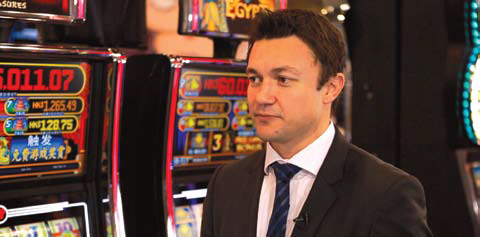
Kurt Gissane






